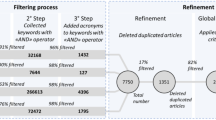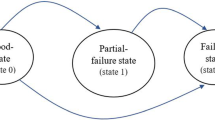Abstract
A modelling methodology is presented for assembly/disassembly systems with general processing time distributions and finite buffers. The approach combines the distributions discretization and a decomposition technique to analyze large manufacturing systems in a reasonable computational time and with good accuracy. In the decomposition technique, the system is decomposed into two station subsystems and the processing time distributions of the virtual stations are iteratively modified to approximate the impact of the rest of the network, adding estimations of the blocking and starving distributions. To analyze each subsystem, the general processing time distributions are discretized by aggregation of the probability masses, and the subsystem is then analytically modeled using a discrete Markov chain. We first show that this approach allows an accurate estimation of the subsystems cycle time distributions, which is crucial in the decomposition technique. Using computational experiments, we show that our decomposition method leads to accurate performance evaluation for large manufacturing systems (relative error on the order of 1%) and that the fine distribution estimation indeed seems to bring an improvement. Furthermore, we show on examples that, using decomposition, the cycle time distributions can be approximated reliably for large systems.











Similar content being viewed by others
Notes
If \(S_3\) is starved by two preceding stations, the starving ends when each station has ended its job. The starvation time to be added to \(S_u(3)\) is thus the maximum of the starvation times computed on \(S_d(1)\) and \(S_d(2)\).
If \(S_2\) is blocked by two successors, the blocking ends when each of them has ended its job. The blocking time to be added to \(S_d(1)\) is thus the maximum of the blocking times computed on \(S_u(2)\) and \(S_u(3)\).
References
Adan I, van Eenige M, Resing J (1994) Fitting discrete distributions on the first two moments. Tech. rep., Department of Mathematics and Computer Science, Eindhoven University of Technology
Altiok T (1985) On the phase-type approximations of general distributions. IIE Trans 17(2):110–116
Altiok T (1989) Approximate analysis of queues in series with phase-type service times and blocking. Oper Res 37(4):601–610
Altiok T (1996) Performance analysis of manufacturing systems. Springer, New York
Andriansyah R, van Woensel T, Cruz FRB, Duczmal L (2010) Performance optimization of open zero-buffer multi-server queueing networks. Comput Oper Res 37(8):1472–1487
Asmussen S, Nerman A, Olsson M (1996) Fitting phase-type distributions via the em algorithm. Scand J Stat 23:419–441
Assaf R, M MC, Matta A (2014) Analytical evaluation of the output variability in production systems with general Markovian structure. OR Spectr 36(3):799–835
Balsamo S, de Nitto Personé V, Onvural R (2001) Analysis of queueing networks with blocking. Kluwer, Dordrecht
Bierbooms R, Adan IJBF, van Vuuren M (2013) Approximate performance analysis of production lines with continuous material flows and finite buffers. Stoch Models 29(1):1–30
Bitran GR, Dasu S (1992) A review of open queueing network models of manufacturing systems. Queueing Syst 12(1–2):95–134
Bobbio A, Cumani A (1992) ML estimation of the parameters of a ph distribution in triangular canonical form. In: Balbo G, Serazzi G (eds) Computer performance evaluation. Elsevier, Amsterdam, pp 33–46
Bobbio A, Telek M (1994) A benchmark for ph estimation algorithms: results for acyclic-ph. Stoch Models 10:661–677
Bobbio A, Horváth A, Scarpa M, Telek M (2003) Acyclic discrete phase type distributions: properties and a parameter estimation algorithm. Perform Eval 54:1–32
Bobbio A, Horváth A, Telek M (2004) The scale factor: a new degree of freedom in phase-type approximation. Perform Eval 56(1–4):121–144
Bobbio A, Horváth A, Telek M (2005) Matching three moments with minimal acyclic phase type distributions. Stoch Models 21:303–326
Botta RF, Harris CM (1986) Approximation with generalized hyperexponential distributions: weak convergence results. Queueing Syst 1(2):169–190
Brandwajn A, Jow Y (1988) An approximation method for tandem queues with blocking. Oper Res 36(1):73–83
Buzacott J, Shanthikumar J (1993) Stochastic models of manufacturing systems. Prentice-Hall, Englewood Cliffs
Colledani M (2013) Performance evaluation of two-stage buffered production systems with discrete general Markovian machines. In: Proceedings of the 7th IFAC conference on manufacturing modelling, management, and control international federation of automatic control, pp 1638–1643
Colledani M, Gershwin S (2013) A decomposition method for approximate evaluation of continuous flow multi-stage lines with general Markovian machines. Ann Oper Res 209:5–40
Colledani M, Tolio T (2011) Integrated analysis of quality and production logistics performance in manufacturing lines. Int J Prod Res 49(2):485–518
Dallery Y, Frein Y (1993) On decomposition methods for tandem queueing networks with blocking. Oper Res 41(2):386–399
Dallery Y, Gershwin S (1992) Manufacturing flow line systems: a review of models and analytical results. Queueing Syst 12:3–94
Dallery Y, Liu Z, Towsley D (1994) Equivalence, reversibility, symmetry and concavity properties in fork/join queueing networks with blocking. J Assoc Comput Mach 41:903–942
de Koster M (1987) Estimation of line efficiency by aggregation. Int J Prod Res 25(4):615–625
Gershwin S (1987) An efficient decomposition method for the approximate evaluation of tandem queues with finite storage space and blocking. Oper Res 35(2):291–305
Gourgand M, Grangeon N, Norre S (2005) Markovian analysis for performance evaluation and scheduling in \(m\) machine stochastic flow-shop with buffers of any capacity. Eur J Oper Res 161:126–147
Govil M, Fu M (1999) Queueing theory in manufacturing: a survey. J Manuf Syst 18(4):214–240
Gun L, Makowski A (1987) An approximation method for general tandem queueing systems subject to blocking. SRC Technical Report, Electrical Engineering Departement and Systems Research Center, University of Maryland
Helber S (1998) Decomposition of unreliable assembly/disassembly networks with limited buffer capacity and random processing times. Eur J Oper Res 109:24–42
Helber S (1999) Performance analysis of flow lines with non-linear flow of material. In: Lecture Notes in Economics and Mathematical Systems, vol 473, Berlin, Heidelberg, New York: Springer
Helber S (2006) Analysis of flow lines with cox-2-distributed processing times and limited buffer capacity. In: Liberopoulos G, Papadopoulos C, Tan B, Smith J, Gershwin S (eds) Stochastic modeling of manufacturing systems. Springer, pp 55–76
Hillier F, Boling R (1967) Finite queues in series with exponential or Erlang service times—a numerical approach. Oper Res 15(2):286–303
Hopp W, Spearman M (1996) Factory physics: foundations of manufacturing management. Irwin, Burr Ridge
Huisman T, Boucherie RJ (2011) Decomposition and aggregation in queueing networks. In: Richard J, Boucherie NMV (ed) Queueing networks: a fundamental approach. Springer, US
Jeong KC, Kim YD (1998) Performance analysis of assembly/disassembly systems with unreliable machines and random processing times. IIE Trans 30(1):41–53
Johnson M, Taaffe M (1989) Matching moments to phase distributions: mixtures of Erlang distributions of common order. Stoch Models 5(4):711–743
Kerbache L, Smith JM (1987) The generalized expansion method for open finite queueing networks. Eur J Oper Res 32:448–461
Kerbache L, Smith JM (1988) Asymptotic behavior of the expansion method for open finite queueing networks. Comput Oper Res 15(2):157–169
Kim S (2011) Modeling cross correlation in three-moment four-parameter decomposition approximation of queueing networks. Oper Res 59(2):480–497
Krieg G, Kuhn H (2002) A decomposition method for multi-product Kanban systems with setup times. IIE Trans 34(7):613–625
Kuhn H (2003) Analysis of automated flow line systems with repair crew interference. In: Gershwin S, Dallery Y, Papadopoulos C, Smith JM (eds) Analysis and modeling of manufacturing systems. Kluwer, New York, pp 155–179
Lagershausen S, Tan B (2015) On the exact inter-departure, inter-start, and cycle time distribution of closed queueing networks subject to blocking. IIE Trans 47(7):673–692
Lang A, Arthur J (1997) Parameter approximation for phase-type distributions. In: Chakravarthy S, Alfa A (eds) Matrix analytical methods in stochastic models. Marcel Dekker, New York, pp 151–206
Leemans H (2001) Waiting time distribution in a two-class two-server heterogeneous priority queue. Perform Eval 43(2–3):133–150
Levantesi R, Matta A, Tolio T (2003) Performance evaluation of continuous production lines with machines having different processing times and multiple failure modes. Perform Eval 51:247–268
Li J, Blumenfeld DE, Huang N, Alden JM (2009) Throughput analysis of production systems: recent advances and future topics. Int J Prod Res 47(14):3823–3851
Liu J, Yang S, Wu A, Hu S (2012) Multi-state throughput analysis of a two-stage manufacturing system with parallel unreliable machines and a finite buffer. Eur J Oper Res 219:296–304
Manitz M (2008) Queueing-model based analysis of assembly lines with finite buffers and general service times. Comput Oper Res 35(8):2520–2536
Manitz M (2015) Analysis of assembly/disassembly queueing networks with blocking after service and general service times. Ann Oper Res 226(1):417–441
Marie R (1980) Calculating equilibrium probabilities for \(\lambda\)(n)/ck/1/n queues. In: Performance’80: proceedings of the 1980 international symposium on computer performance modelling, measurement and evaluation, ACM, New York, NY, USA, pp 117–125
Neuts M (1981) Matrix-geometric solutions in stochastic models: an algorithmic approach. Dover Publications, New York
Osogami T, Harchol-Balter M (2006) Closed form solutions for mapping general distributions to quasi-minimal ph distributions. Perform Eval 63(6):524–552
Papadopoulos H, Heavey C (1996) Queueing theory in manufacturing systems analysis and design: a classification of models for production and transfer lines. Eur J Oper Res 92:1–27
Pearson E, Johnson N, Burr I (1979) Comparisons of the percentage points of distributions with the same first four moments, chosen from eight different systems of frequency curves. Commun Stat Simul Comput 8(3):191–229
Sauer C, Chandy K (1975) Approximate analysis of central server models. IBM J Res Dev 19(3):301–313
Shi C, Gershwin SB (2016) Part sojourn time distribution in a two-machine line. Eur J Oper Res 248(1):146–158
Tan B (2003) State-space modeling and analysis of pull-controlled production systems. In: Gershwin S, Dallery Y, Papadopoulos C, Smith JM (eds) Analysis and modeling of manufacturing systems. Kluwer, pp 363–398
Tan B, Gershwin S (2009) Analysis of a general markovian two-stage continuous-flow production system with a finite buffer. International Journal of Production Economics 120:327–339
Tancrez JS (2009) Modelling queueing networks with blocking using probability mass fitting. PhD thesis, Catholic University of Louvain
Tancrez JS, Chevalier P, Semal P (2011) Probability masses fitting in the analysis of manufacturing flow lines. Annals of Operations Research 182(1):163–191
Telek M (2000) Minimal coefficient of variation of discrete phase type distributions. 3rd International Conference on Matrix-Analytic Methods in Stochastic models, MAM3. Notable Publications Inc., Leuven, Belgium, pp 391–400
Tempelmeier H, Burger M (2001) Performance evaluation of unbalanced flow lines with general distributed processing times, failures and imperfect production. IIE Transactions 33:293–302
Terracol C, David R (1987) An aggregation method for performance evaluation of transfer lines with unreliable machines and finite buffers. In: IEEE Conference on Robotics and Automation, Raleigh, NC
van Vuuren M, Adan I (2006) Performance analysis of assembly systems. In: A N Langville WJS (ed) MAM 2006: Markov Anniversary Meeting, Boson Books, Raleigh, North Carolina, USA, pp 89–100
Whitt W (1982) Approximating a point process by a renewal process, i: Two basic methods. Operations Research 30(1):125–147
Author information
Authors and Affiliations
Corresponding author
Additional information
Publisher's Note
Springer Nature remains neutral with regard to jurisdictional claims in published maps and institutional affiliations.
Rights and permissions
About this article
Cite this article
Tancrez, JS. A decomposition method for assembly/disassembly systems with blocking and general distributions. Flex Serv Manuf J 32, 272–296 (2020). https://doi.org/10.1007/s10696-019-09332-z
Published:
Issue Date:
DOI: https://doi.org/10.1007/s10696-019-09332-z




